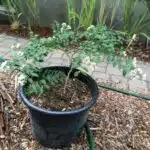Licorice plants are a popular choice for gardeners and horticulturists alike, as they add a unique touch of flavor and texture to any landscape. These plants are known for their medicinal properties and have been used in traditional medicine for centuries. Growing licorice plants requires some attention to detail, but with the right techniques, anyone can grow these plants in their gardens or containers.
If you’re looking to add licorice plants to your garden or container collection, there are a few things you need to know. First, it’s important to understand the growing conditions that are best suited for these plants. They thrive in warm climates and well-drained soil, so if you live in an area with cold winters or heavy rainfall, you may need to take extra precautions to ensure their survival. Additionally, licorice plants require regular pruning and fertilization to maintain their health and vitality. With the right care and attention, however, these plants can provide years of enjoyment and culinary delight for any gardener or chef.
Understanding Licorice Plants
Licorice plants, also known as Glycyrrhiza glabra, are native to the Mediterranean region and have been used for centuries in traditional medicine. They belong to the legume family and can grow up to 4 feet tall with a spread of 3 feet. The plant’s roots contain glycyrrhizin, which gives it a sweet flavor and makes it a popular ingredient in candies, teas, and other confectionery products.
Uses and benefits of licorice plants include its ability to soothe sore throats and coughs, reduce inflammation, and aid digestion. It is also known for its anti-viral properties and has been used to treat hepatitis C. In traditional Chinese medicine, licorice root is often combined with other herbs to treat a variety of ailments such as ulcers and respiratory infections.
History and folklore surrounding licorice plants are abundant. Ancient Egyptians used licorice root as a cure-all for everything from asthma to stomach pain. The Greeks were known to chew on the root as a way to quench their thirst during long journeys. In medieval Europe, it was believed that licorice could ward off evil spirits.
Selecting the right licorice variety is crucial before planting in gardens or containers. Different varieties have different growth habits and may require specific soil conditions or sunlight exposure. Therefore, it is essential to research the different types available before making any purchases.
Selecting The Right Licorice Variety
Licorice plants should be chosen based on their hardiness, taste, and harvesting time. Licorice varieties vary in their tolerance to different temperatures, soil types, and climates. The flavor of licorice plants can range from sweet to spicy depending on the variety. When selecting a variety, the harvest time should be taken into consideration, as some varieties are more suited to warmer climates and longer growing seasons. Additionally, the flavor and texture of the licorice root will depend on the variety and how long it has been in the ground. Lastly, licorice plants can be grown in gardens or containers, but care must be taken to ensure proper drainage.
Hardiness
Understanding hardiness is crucial when selecting the right licorice variety for your garden or container. Licorice plants are native to Mediterranean regions and thrive in warm, dry climates. However, there are some varieties that can tolerate colder temperatures and even frost. When choosing a licorice plant, it’s important to consider its hardiness zone rating, which indicates the lowest temperature the plant can withstand.
Winter care is also an essential factor to consider when growing licorice plants. Most varieties go dormant during winter and require little maintenance. It’s important to keep the soil moist but not waterlogged during this period, as excessive moisture can lead to root rot. In colder climates, it’s recommended to cover the plants with a thick layer of mulch or straw to protect them from freezing temperatures.
Overall, selecting a licorice variety that is suited for your climate and providing adequate winter care are key factors in successfully growing these plants in your garden or containers. By understanding their hardiness and taking proper precautions during winter, you can enjoy a bountiful harvest of this unique and flavorful herb.
Taste
After considering the hardiness and winter care of licorice plants, another crucial factor to consider is taste. Licorice flavor is a popular ingredient in cuisine and has been used for centuries for both culinary and medicinal purposes. The licorice root, which is the part of the plant used for these purposes, contains compounds such as glycyrrhizin that give it a distinct sweet and slightly bitter taste.
In terms of culinary uses, licorice flavor can be found in a variety of dishes ranging from sweet desserts to savory meat dishes. It’s commonly used in confectionery and candy-making where licorice extract or powder is added to sweets to impart its unique flavor. Licorice flavor can also be found in beverages such as tea and alcoholic drinks like absinthe.
Aside from its culinary uses, licorice root has been utilized for its health benefits as well. It possesses anti-inflammatory properties that can help soothe sore throats and coughs, making it a common ingredient in traditional medicine. Licorice root also contains antioxidants that may help protect against certain diseases such as heart disease and cancer.
Understanding the taste profile of different licorice varieties can aid in selecting the right one for your intended use whether it be culinary or medicinal. By considering both the hardiness and taste factors, you can successfully grow and utilize this versatile herb in your garden or containers.
Harvesting Time
After considering the hardiness and taste profile of licorice plants, it’s important to discuss the timing of harvesting. Harvesting at the right time is crucial for obtaining high-quality roots that can be used for medicinal or culinary purposes. Best practices for preserving licorice roots include harvesting them in the fall after about three years of growth.
To identify the perfect time to harvest licorice roots, gardeners should pay attention to the plant’s growth cycle. Licorice plants typically grow during the spring and summer months, and their root system develops during this time as well. In the fall, the leaves will begin to turn yellow, signaling that it’s time to harvest. The best way to harvest is by digging up the entire plant and carefully removing the roots.
Once harvested, it’s important to clean and dry the roots properly to preserve their flavor and medicinal properties. Gardeners should remove any dirt or debris from the roots and cut them into smaller pieces before drying them in a well-ventilated area. By following these best practices for harvesting and preserving licorice roots, gardeners can ensure that they have high-quality herbs that can be enjoyed for years to come.
Choosing The Right Location For Your Licorice Plants
The location where you plant your licorice plants plays a crucial role in their growth and development. Just like humans, these plants thrive in areas that provide them with the optimal conditions to grow and flourish. Choosing the right location for your licorice plants can make all the difference between a healthy and thriving crop or one that struggles to survive.
Here are three essential factors to consider when choosing a location for your licorice plants:
Best soil conditions for licorice plants – These plants require well-draining soil that is rich in nutrients. Licorice roots grow deep into the soil, which means they need adequate space to spread out. Soil that is too compact or clay-like may stunt their growth.
Sun and shade conditions for licorice plants – Although licorice plants prefer full sun, they also need some shade during hot summer days, especially when grown in containers. Placing them in an area with partial shade will provide them with a break from direct sunlight.
Common mistakes to avoid when choosing a location for licorice plants – Avoid planting them near other competitive crops as they tend to dominate the surrounding area. Also, stay away from areas that are prone to waterlogging as this may cause root rot, leading to stunted growth or death of your crop.
Choosing the best location for your licorice plants is critical if you want them to thrive and produce healthy yields. Keep these three factors in mind when selecting an area in your garden or container, and you’ll be on track towards success! In the next section, we’ll discuss how preparing the soil correctly can help ensure optimal growing conditions for your licorice plants.
Preparing The Soil For Licorice Plants
After selecting the right location for your licorice plants, it’s time to prepare the soil. Licorice plants prefer loose and well-draining soil that is rich in organic matter. Before planting, make sure to loosen the soil at least 12 inches deep and incorporate a generous amount of compost or well-rotted manure.
Licorice plants have specific nutrient requirements that must be met for optimal growth. They need a balanced fertilizer with equal parts nitrogen, phosphorus, and potassium. Additionally, they require high levels of calcium and magnesium in the soil. It’s important to conduct a soil test before planting to determine if any deficiencies exist.
To ensure proper nutrient uptake, it’s recommended to apply fertilizer in small amounts throughout the growing season rather than all at once. Licorice plants are heavy feeders, so regular fertilization is necessary for healthy growth. Make sure not to over-fertilize as this can lead to excessive vegetative growth at the expense of root development.
Now that you’ve prepared your soil and understand the nutrient requirements of licorice plants, you’re ready to start planting them in your garden or container. In the next section, we’ll discuss step-by-step instructions on how to plant licorice in gardens and containers for optimal growth and yield.
Planting Licorice In Gardens
Choosing a Location: Licorice plants require a sunny location with a minimum of 6-8 hours of direct sunlight a day.
Planting and Spacing: Licorice plants should be planted at least two feet apart to allow for adequate air circulation.
Compost: Compost should be added to the soil when planting to ensure optimal growth of the plant.
Mulch: Organic mulch should be added to the soil after planting to help retain moisture and control weeds.
Watering: Licorice plants should be watered deeply and regularly to ensure that the soil stays moist.
Fertilization: Licorice plants should be fertilized every few months with a balanced fertilizer to provide the necessary nutrients for healthy growth.
Choosing A Location
When it comes to planting licorice in gardens, choosing the right location is crucial to ensure its growth and survival. Licorice plants thrive in full sun, so it’s important to select a spot with at least six hours of direct sunlight per day. Ideal conditions for growing licorice also include well-draining soil that is slightly acidic, with a pH range of 6.0 to 7.0.
Avoiding pitfalls is also essential when selecting a location for your licorice plant. One common mistake is planting it in an area that gets too much shade or has poor drainage. This can lead to root rot, stunted growth, and ultimately, the death of the plant. Additionally, it’s important to avoid planting licorice near other plants that may compete for nutrients or have different watering needs.
In summary, choosing the right location for your licorice plant is key to its success in your garden. Keep in mind the ideal conditions and potential pitfalls when selecting a spot that receives plenty of sunlight and has well-draining soil with a slightly acidic pH level. By avoiding common mistakes such as poor drainage or competition from neighboring plants, you can ensure your licorice plant will thrive and provide you with delicious and healthy roots for years to come.
Planting And Spacing
After selecting the right location for your licorice plant, the next step is to consider planting and spacing requirements. When it comes to planting, it’s best to sow licorice seeds directly into the ground in early spring or fall. The seeds should be planted at a depth of one inch and spaced four inches apart. If you’re using root cuttings instead of seeds, they should be planted in late winter or early spring, spaced 18 inches apart with a depth of two inches.
Spacing requirements are crucial when growing licorice as the plants can spread out significantly over time. They require ample space to grow and spread their roots, which can reach up to six feet deep and ten feet wide. Therefore, it’s recommended that you plant licorice in rows that are three to four feet apart with individual plants spaced 18 inches apart within each row.
Companion planting is another important aspect of growing licorice plants. It’s best to avoid planting them near other legumes such as beans or peas as they can attract similar pests and diseases. Instead, consider companion planting with herbs such as rosemary or thyme, which can help repel pests and improve soil quality. Planting licorice alongside other perennial herbs and vegetables like sage or artichokes can also create a diverse and thriving garden ecosystem.
Compost And Mulch
As a horticultural expert or garden specialist, it’s essential to consider composting techniques and mulching methods when planting licorice in gardens. Composting is a natural process that involves breaking down organic materials to create nutrient-rich soil amendments. This technique is particularly useful for licorice plants as they require fertile soil with good drainage. To make your own compost, start by collecting kitchen scraps, yard waste, and other organic matter in a bin or pile. Over time, the materials will decompose and transform into dark brown, crumbly soil that can be used to nourish your licorice plants.
Mulching is another crucial aspect of growing healthy licorice plants in gardens. Mulch helps to retain moisture in the soil, suppress weeds, and regulate soil temperature. There are several types of mulch you can use when planting licorice plants, including straw, wood chips, leaves, and grass clippings. When applying mulch around your licorice plants, make sure to spread it evenly over the soil surface without touching the plant stems or leaves.
In summary, composting techniques and mulching methods are vital components of growing successful licorice plants in gardens. Composting provides nutrient-rich soil amendments that can support the growth of these vigorous plants while mulching helps to retain moisture and regulate soil temperature. By incorporating these practices into your gardening routine alongside proper planting and spacing requirements and companion planting strategies discussed earlier; you can grow thriving licorice plants that will provide you with years of enjoyment and health benefits.
Planting Licorice In Containers
Growing licorice plants in containers can be a fun and rewarding experience. With the right container selection and maintenance tips, you can easily grow these flavorful plants on your patio or balcony. Choosing the right container is crucial for the success of your plant. A container that is too small will restrict root growth, while a container that is too large will hold too much moisture and increase the risk of root rot.
When selecting a container for your licorice plant, choose one that is at least 12 inches deep and wide enough to accommodate its size. Make sure it has drainage holes to prevent water from accumulating at the bottom. Terracotta pots are ideal as they allow air circulation and help regulate soil moisture levels. It’s also important to use high-quality potting soil that drains well and contains organic matter.
Proper maintenance is also essential for growing licorice plants in containers. These plants prefer full sun or partial shade and require regular watering, especially during hot weather. Fertilize them with a balanced liquid fertilizer every two weeks during the growing season to promote healthy growth. Prune them regularly to maintain their shape and prevent overcrowding in the container.
In summary, growing licorice plants in containers requires careful consideration of container selection and proper maintenance techniques such as regular watering, fertilizing, pruning, and using high-quality potting soil. In the next section, we will discuss the importance of proper watering techniques for your licorice plant’s health and growth.
Watering Licorice Plants
- Watering licorice plants should be done regularly and consistently to keep the soil moist.
- The amount of water required for licorice plants varies depending on the type of soil, climate, and season.
- In general, licorice plants should be watered about twice a week during the growing season, allowing the surface of the soil to dry out between waterings.
- It is important to avoid over-watering, which can lead to root rot and other issues.
- To test the soil moisture level, stick a finger into the soil to a depth of 2-3 inches.
- If the soil is dry, the licorice plant should be watered until the water runs out of the bottom of the container.
Amount Of Water
As a gardening enthusiast, it is important to understand the proper watering technique for licorice plants. These plants have specific soil moisture requirements that should be taken into consideration. One of the main factors that affect their growth is watering frequency.
Licorice plants need to be watered consistently but not excessively. The ideal frequency of watering depends on several factors such as temperature, humidity levels, and soil type. Generally, they require regular watering during the growing season, while less frequent watering is needed during winter or dormant periods. To prevent overwatering or underwatering, gardeners must check the soil moisture level regularly.
In order to maintain healthy licorice plants, it is recommended to water them when the top inch of soil feels dry to the touch. The amount of water required also depends on the size and location of the plant. For container-grown licorice plants, it is essential to ensure adequate drainage and avoid waterlogging in order to prevent root rot. By following these guidelines for watering frequency and soil moisture requirements, gardeners can successfully grow licorice plants in gardens or containers with ease.
Frequency Of Watering
Maintaining optimal soil moisture is crucial to the healthy growth of licorice plants. Watering frequency plays a vital role in preventing overwatering or underwatering. Licorice plants should be watered consistently, but not excessively, depending on various factors such as temperature, humidity levels, and soil type. During the growing season, regular watering is needed while less frequent watering is required during winter or dormant periods.
To prevent overwatering, gardeners must check the soil moisture level regularly. Overwatering can lead to root rot and other diseases that can harm the plant’s health. On the other hand, inadequate watering can cause the leaves to wilt and turn yellowish-brown. To maintain healthy licorice plants, it is recommended to water them when the top inch of soil feels dry to the touch. The amount of water required also depends on the size and location of the plant.
Preventing overwatering is essential for container-grown licorice plants as they are more susceptible to root rot due to inadequate drainage. Adequate drainage should be ensured by creating holes at the bottom of containers for excess water to drain out quickly. To avoid waterlogging, it is recommended not to let water stand in saucers or trays under containers. By following these guidelines for optimal watering frequency and overwatering prevention techniques, gardeners can successfully grow licorice plants in gardens or containers with ease while maintaining their health and vigour.
Soil Moisture Levels
Maintaining optimal soil moisture levels is crucial for the healthy growth of licorice plants. Testing the soil regularly is essential to prevent overwatering, which can lead to root rot and other diseases that may harm the plant’s health. On the other hand, inadequate watering can cause leaves to wilt and turn yellowish-brown. Therefore, it is necessary to water licorice plants consistently but not excessively, depending on various factors such as temperature, humidity levels, and soil type.
To test soil moisture levels, gardeners should insert a finger or a moisture meter into the soil at least an inch deep. If the top inch of soil feels dry to the touch, it’s time to water the plant. However, if it feels moist or wet, it’s best to hold off on watering until it dries out a bit more. Overwatering can be prevented by ensuring adequate drainage in containers and planting beds. Creating holes at the bottom of containers allows excess water to drain out quickly and avoid waterlogging.
In conclusion, maintaining optimal soil moisture levels is vital for growing healthy licorice plants successfully. By testing soil moisture regularly and preventing overwatering through adequate drainage techniques, gardeners can ensure that their plants grow vigorously without any harm or disease. With these guidelines in mind, anyone can grow beautiful and thriving licorice plants in gardens or containers with ease while serving others’ needs for beauty and nourishment from nature.
Fertilizing Licorice Plants
After properly watering your licorice plants, it’s important to fertilize them regularly to ensure their growth and health. There are two types of fertilizers available for your plants: organic and synthetic. Organic fertilizers are made from natural materials such as manure, compost, or bone meal. Synthetic fertilizers, on the other hand, are produced chemically in a laboratory.
Organic fertilizers provide a slow-release of nutrients over time and can improve soil quality. They also reduce the risk of chemical buildup in the soil and promote microbial activity. However, they may not provide immediate results and may require more frequent applications. Synthetic fertilizers provide an immediate boost of nutrients and are easier to apply but can contribute to chemical buildup in the soil if overused.
When selecting a fertilizer for your licorice plant, consider the specific nutrient requirements of the plant and choose a balanced fertilizer that contains equal amounts of nitrogen, phosphorus, and potassium. It’s recommended to fertilize your licorice plants every 4-6 weeks during the growing season.
- To prevent nutrient leaching, avoid watering immediately after applying fertilizer.
- Use caution when applying synthetic fertilizers as they can burn plant roots if applied incorrectly.
- Consider using compost tea or fish emulsion as organic alternatives for bolstering soil fertility.
- Test your soil frequently to determine which nutrients need supplementation by monitoring pH levels.
Transition: Now that you’ve learned about the different types of fertilizers available for your licorice plants and how to properly apply them let’s move onto pruning techniques that will keep your plants healthy and productive.
Pruning Licorice Plants
- Pruning licorice plants is an important part of the overall care of the plant and should be done when the plant is actively growing, usually in the spring.
- The main pruning techniques to use when pruning licorice plants include thinning, deadheading, and removing any diseased or damaged branches.
- Regular pruning will encourage bushier growth while keeping the overall height and spread of the licorice plant in check.
- It is important to use sharp tools when pruning licorice plants to avoid damaging the branches and leaves.
When To Prune
Pruning licorice plants is a crucial part of their maintenance, and knowing when to prune can make all the difference in their growth and health. The best time to prune licorice plants is during the fall or early spring, before new growth begins. This allows for optimal regrowth and helps prevent any damage that may occur during the winter months.
When pruning licorice plants, it’s important to use the proper tools to avoid causing any damage or injury. The best tools for pruning are sharp, clean shears or scissors. Avoid using dull or rusty blades as they can tear the plant’s tissue, leading to potential disease or pest problems. Additionally, be sure to disinfect your tools before each use to prevent the spread of any diseases.
Common mistakes to avoid when pruning licorice plants include over-pruning and cutting too close to the base of the plant. Over-pruning can cause stress on the plant and hinder its growth, while cutting too close to the base can damage the crown of the plant, which could ultimately lead to its demise. Instead, aim for a light trim and focus on removing any dead, diseased, or damaged branches. By following these guidelines and avoiding common mistakes, you’ll be able to successfully prune your licorice plants for optimal growth and health.
Pruning Techniques
Pruning techniques are essential in maintaining the health and growth of licorice plants. Pruning is the process of removing unwanted branches and foliage to encourage new growth, increase air circulation, and prevent disease. The benefits of pruning include promoting fruit production, shaping the plant, and controlling its size. However, there are common mistakes that gardeners should avoid when pruning licorice plants to ensure their success.
One of the most common mistakes is pruning too much or too often. Over-pruning can cause stress on the plant, which could lead to a decline in its overall health. Therefore, gardeners should aim for light trimming during each session rather than heavy pruning all at once. Another mistake is cutting too close to the base of the plant. This could damage the crown, which may lead to root rot or fungal infection.
To maintain proper pruning techniques for licorice plants, it’s important to use sharp and clean tools such as shears or scissors. Dull blades can cause tears in the tissue that may lead to diseases or pests’ infestations. Gardeners should disinfect their tools before each use to prevent any spread of disease from one plant to another. By following these guidelines and avoiding common mistakes while pruning licorice plants, gardeners will achieve optimal growth and health for their plants while enhancing their landscape’s beauty.
Dealing With Pests And Diseases
Like any other plant, licorice plants are also prone to pests and diseases. They can be affected by various pests such as spider mites, aphids, slugs, and snails. Diseases such as root rot and powdery mildew can also affect the health of the plant. However, with proper care and attention, these problems can be prevented.
Natural remedies can be used to prevent pests from attacking licorice plants. For instance, planting garlic and chives near the licorice plant can help repel aphids. Diatomaceous earth is an effective remedy for controlling slugs and snails. It is essential to monitor the plants regularly for signs of infestation so that action can be taken immediately.
Preventing pest infestations is always better than finding a cure later. Regular watering, pruning of dead leaves, and maintaining a clean garden environment are some of the measures that can help prevent pest outbreaks. In case you do find an infestation or disease in your licorice plants, it would be wise to opt for natural remedies first before resorting to chemical solutions.
Now that we have discussed how to prevent pests and diseases in licorice plants let us move onto harvesting its roots.
Harvesting Licorice Roots
- Collecting licorice roots requires careful digging around the base of the plant to ensure the entire root system is removed intact.
- The roots should then be washed thoroughly to remove any dirt and debris.
- Afterwards, the roots should be spread out in a single layer on a tray or screen to allow them to dry.
- When the roots are dry, they should be cut into small pieces and stored in an airtight container.
- To ensure the licorice roots keep their flavor, it is important to store them in a cool, dry place.
- It is also important to check the container periodically for any signs of moisture or mold, which can ruin the quality of the licorice roots.
Collecting Roots
The collection of licorice roots is a crucial step in harvesting them for various uses. The best time to collect the roots is during the fall season when they are at their peak size and flavor. It is essential to wait until the plant has reached at least three years of age before collecting its roots. This allows sufficient time for the plant to establish strong roots that can withstand the stress of being harvested.
Once it’s time to collect, dig around the base of the plant and loosen the soil with a fork. Gently remove any dirt from around the roots, but avoid damaging them as much as possible. Cut off any side roots and leave only those that are straight and long enough. Afterward, wash them thoroughly and dry them in a warm place away from direct sunlight.
Licorice has been used for centuries due to its many health benefits such as alleviating respiratory problems, soothing sore throats, and regulating blood sugar levels. It’s also popularly used in teas, candies, and chewing gums due to its sweet taste. With proper harvesting techniques, growing licorice plants in gardens or containers can be an enjoyable experience that provides one with a readily available source of this beneficial herb for personal use or even sale.
Cleaning Roots
After successfully collecting the licorice roots, the next step is to clean them properly. Proper cleaning ensures that the roots are free from dirt and debris that may harbor pathogens or introduce mold growth during storage. Cleaning equipment such as a soft-bristled brush, damp cloth, or running water can be used to remove any loose soil or debris from the roots.
It is crucial to preserve the quality of the roots during cleaning by avoiding excessive scrubbing or soaking in water for extended periods. The roots should not be exposed to direct sunlight or high temperatures during drying, as this may result in a loss of flavor and potency. Instead, they should be dried in a warm, well-ventilated area until they are firm but pliable.
Once the roots are clean and dry, they can be stored in airtight containers away from direct sunlight and moisture. This will help preserve their quality and keep them fresh for longer periods. Properly cleaned and preserved licorice roots can be used for various purposes such as making tea or extracts that offer numerous health benefits, making candy or chewing gum with its sweet taste, or even selling them for commercial purposes.
Drying Roots
After properly cleaning the licorice roots, the next step is to dry them. Drying the roots is essential in preserving their medicinal properties and sweet taste, making them useful for various culinary uses. It is important to avoid exposing the roots to direct sunlight or high temperatures during drying as this may result in a loss of flavor and potency.
To dry the roots, they should be placed in a warm, well-ventilated area until they are firm but pliable. This process can take several days to weeks depending on the thickness of the roots. It is best to check on them regularly and turn them over to ensure even drying.
Once fully dried, the licorice roots can be stored in airtight containers away from direct sunlight and moisture. Properly dried and preserved licorice roots can be used for making tea or extracts that offer numerous health benefits, candy or chewing gum with its sweet taste, or even sold for commercial purposes. The process of harvesting and preparing licorice roots requires patience and attention to detail but results in a valuable ingredient that has been used for centuries for its medicinal properties and culinary uses.
Storing And Using Licorice Roots
After harvesting your licorice plants, it is essential to store the roots correctly to prevent spoilage. Start by brushing off any loose soil and gently washing the roots with cool water. Next, cut them into small pieces for drying. You can use a dehydrator or hang them in a dry, well-ventilated area until they are completely dry. Once dried, store them in an airtight container away from sunlight and moisture.
Licorice root has been used for medicinal purposes for centuries due to its anti-inflammatory and soothing properties. It can be used in many herbal remedies, such as teas and tinctures. To make a licorice tea, steep one teaspoon of dried licorice root in hot water for 5-10 minutes. You can also add other herbs like ginger or cinnamon to enhance the flavor.
Incorporating licorice into your daily routine can provide several health benefits. However, it’s important to note that excessive consumption of licorice can lead to side effects such as high blood pressure and potassium deficiency. As with any herbal remedy, consult with a healthcare professional before adding it to your diet. In the next section, we will discuss how to propagate your own licorice plants so that you can continue growing this beneficial herb at home.
Propagating Licorice Plants
To ensure a healthy and robust licorice plant, proper care is essential. From watering to fertilizing, every aspect must be managed well. Here are some tips for caring for your licorice plant:
- Soil: Licorice plants thrive in loose, well-drained soil with a pH of 6-8. Ensure that the soil is rich in organic matter and has good drainage.
- Watering: Avoid overwatering the plant as it can cause root rot. Water the plant when the top layer of soil feels dry to touch.
- Fertilizing: Licorice plants do not require frequent fertilization, but you can feed them with a balanced fertilizer once or twice during the growing season.
Propagation techniques for licorice plants are relatively simple and can be done by seeds or cuttings:
- Seeds: Sow the seeds in early spring in moist soil and keep them in a warm place until they germinate.
- Cuttings: Take cuttings from mature plants during spring or summer and dip them in rooting hormone before planting them in moist soil.
With proper care and propagation techniques, your licorice plant will grow into a healthy and thriving one!
Troubleshooting Common Issues
After successfully propagating licorice plants, it’s time to focus on growing them in your garden or containers. As with any plant, it’s crucial to monitor for symptoms of common issues that may arise during the growth process. Identifying these problems early on will allow you to apply organic solutions and prevent further damage.
One common issue is powdery mildew, which appears as a white, powdery substance on the leaves. This fungus thrives in humid conditions and can spread quickly if left untreated. To combat powdery mildew, remove any infected leaves and increase air circulation by spacing out your plants or using a fan. You can also apply a mixture of baking soda and water or neem oil to affected areas.
Another issue is root rot, which occurs when the roots are overwatered or the soil is not well-draining. Signs of root rot include yellowing leaves and wilting stems. To prevent this problem, make sure to plant your licorice in well-draining soil and avoid overwatering. If root rot has already set in, you can try adjusting watering habits and applying a solution of hydrogen peroxide and water to the affected area.
By identifying symptoms early on and applying organic solutions, you can ensure healthy growth for your licorice plants. With proper care, you’ll soon be enjoying the benefits of these versatile plants in your own garden or containers.
Enjoying The Benefits Of Licorice Plants
As you enjoy the beauty of your licorice plants in your garden or container, you can also benefit from its medicinal properties. The root of the licorice plant contains glycyrrhizin, a compound that has been used for centuries in natural remedies for respiratory problems, digestive issues, and skin conditions. Incorporating licorice into your diet can also have positive effects on your health.
One way to use licorice for natural remedies is to make a tea using the dried root. Licorice tea can help soothe sore throats, reduce inflammation in the respiratory tract, and aid digestion. Licorice root extract can also be used topically to treat eczema and other skin irritations.
Incorporating licorice into your diet is easy and delicious. You can add licorice root powder to smoothies or use it as a sweetener in baking recipes. Licorice root tea can also be enjoyed as a refreshing beverage. As with any herbal remedy or supplement, it’s important to speak with a healthcare professional before adding licorice to your routine. With its many benefits and versatility, growing licorice plants in your garden or container is a great way to enhance both the beauty of your space and your overall well-being.
Conclusion
Licorice plants are a unique addition to any garden or container. Understanding the different varieties of licorice, selecting the right location and soil, and proper planting techniques will lead to successful cultivation. It is important to note that licorice roots have medicinal properties and can be used for various purposes, making it a valuable plant to grow.
When choosing a licorice variety, consider factors such as climate, soil type, and intended use. Licorice plants prefer well-drained soil and full sun exposure. Proper preparation of the soil by adding organic matter and maintaining moisture levels will result in healthy growth. Propagation can be achieved through root cuttings or seed, with careful attention to spacing and watering requirements.
While pests such as aphids and root rot may pose challenges to cultivation, troubleshooting techniques are available. With patience and care, growing licorice plants can be both rewarding and beneficial. The allusion of the sweet taste of licorice candy may entice gardeners to try their hand at growing this unique plant in their own gardens or containers.
Image Credits
- “Licorice Flower” by ElleFlorio (featured)





























